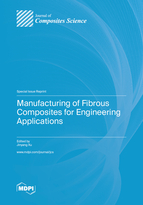Manufacturing of Fibrous Composites for Engineering Applications
A special issue of Journal of Composites Science (ISSN 2504-477X). This special issue belongs to the section "Composites Manufacturing and Processing".
Deadline for manuscript submissions: closed (30 November 2022) | Viewed by 24230
Special Issue Editor
Interests: fibrous composites; metallic alloys; hybrid composite stacks; high-performance materials; functional surfaces; multilayer coatings; coating evaluation; coated tools; mechanical machining; materials processing; numerical modeling surface texturing
Special Issues, Collections and Topics in MDPI journals
Special Issue Information
Dear Colleagues,
Fibrous composites are one type of high-performance composite material featuring the presence of fiber-like reinforcement impregnated with different matrix bases, which have taken a prominent position in diverse engineering applications because of their unique mechanical/physical properties and outstanding structural functions. Manufacturing is a critical procedure to ensure the target dimensions and desired quality of fibrous composites. This involves technical issues frequently encountered in the fabrication, processing, and machining of these composite materials. To date, great endeavors have been made in the past few decades to address manufacturing issues associated with the engineering applications of fibrous composites. Precision manufacturing of these advanced composites has thus become a hot research topic in both academia and industry. Recent advances have been achieved covering both experimental and numerical investigations of manufacturing science and technology of fibrous composites.
This Special Issue seeks to report the latest research findings achieved by worldwide scholars focusing on the manufacturing science of fibrous composites for engineering applications. Well-organized papers covering both experimental and numerical studies of fabricating, processing, and machining fibrous composites are all welcome. It is our hope that this Special Issue will provide a platform for academic and industrial researchers to share and disseminate their original research results on all manufacturing aspects of fibrous composites.
Prof. Dr. Jinyang Xu
Guest Editor
Manuscript Submission Information
Manuscripts should be submitted online at www.mdpi.com by registering and logging in to this website. Once you are registered, click here to go to the submission form. Manuscripts can be submitted until the deadline. All submissions that pass pre-check are peer-reviewed. Accepted papers will be published continuously in the journal (as soon as accepted) and will be listed together on the special issue website. Research articles, review articles as well as short communications are invited. For planned papers, a title and short abstract (about 100 words) can be sent to the Editorial Office for announcement on this website.
Submitted manuscripts should not have been published previously, nor be under consideration for publication elsewhere (except conference proceedings papers). All manuscripts are thoroughly refereed through a single-blind peer-review process. A guide for authors and other relevant information for submission of manuscripts is available on the Instructions for Authors page. Journal of Composites Science is an international peer-reviewed open access monthly journal published by MDPI.
Please visit the Instructions for Authors page before submitting a manuscript. The Article Processing Charge (APC) for publication in this open access journal is 1800 CHF (Swiss Francs). Submitted papers should be well formatted and use good English. Authors may use MDPI's English editing service prior to publication or during author revisions.
Keywords
- fibrous composites
- composite structures
- CFRPs
- GFRPs
- KFRPs
- fabrication
- processing
- machining
- surface quality
- experiments
- numerical simulation






